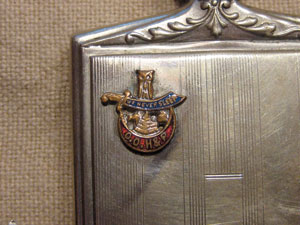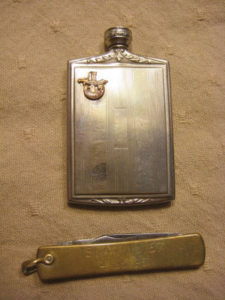 Captain Bob sent me a photograph of some antique Odd Fellows memorabilia. The metal vessel, he says is for perfume. The flask is accompanied by a pocket knife with two blades. Both items are related by similar inscriptions, “Islam No. 57” and “Islam No. 157, ” with the date of “4-25-25” on both. The reverse side of the vessel shows a small colored enameled logo of an owl standing on a scimitar over a crescent with the inscription “WE NEVER SLEEP,” bearing the initials O. O. H & P.
Captain Bob sent me a photograph of some antique Odd Fellows memorabilia. The metal vessel, he says is for perfume. The flask is accompanied by a pocket knife with two blades. Both items are related by similar inscriptions, “Islam No. 57” and “Islam No. 157, ” with the date of “4-25-25” on both. The reverse side of the vessel shows a small colored enameled logo of an owl standing on a scimitar over a crescent with the inscription “WE NEVER SLEEP,” bearing the initials O. O. H & P.
Although I know a little about Captain Bob’s object, I welcome your emailed suggestions.
What I do know:
Captain Bob’s flask and knife are not related to Islam as we know it. They are related to a fantasy of Islam created by the Independent Order of Odd Fellows.
Do not confuse Odd Fellows with Masons, another fraternal organization. They were both established with similar terminology and iconography, most of it Near East and Middle East myths and symbols. The IOOF came to America in the early 19th century via England, founding the Grand Lodge in Baltimore in 1821. One hundred years later, like Captain Bob’s artifacts, dated in the 1920s, we see the American IOOF numbered more than 2 million members at its peak.
Captain Bob’s story gets really interesting:

He says he doesn’t understand why his family owned any object relating to “Islam” because “my family has been culturally Jewish” for the past three or four generations, as far as he knows. Since Captain Bob didn’t know of the objects’ connection to the Odd Fellows, now he will become more perplexed. The history of Jews in fraternal organizations is a story unto itself.
So what role did Jews play in fraternal organizations like the Masons and Odd Fellows in the 1920s? These organizations were very different. Masons seemed to have varying opinions on exclusionary membership throughout its long history. The Odd Fellows, however, seemed to have at its base a more inclusionary membership. According to the Lutherans Informed About Lodges website, the Odd Fellows seem to include any male member who believes in one God. Quoting the IOOF manual, written in 1895 by the “venerated spokesman,” the Universalist Minister the Rev. A. B. Grosh, “The prayers of the Odd Fellows are designed to be universally acceptable.” A verse taken from a song in the Odd Fellows’ ritual states: “A temple where no narrow creed/Protects a chosen few/It holds alike deserved heed/To Christian, Turk and Jew.”
Did Captain Bob’s ancestor belonged to Odd Fellows in New York in the 1920s?
Like most early 20th century fraternal organizations, the Odd Fellows collected membership dues on a quarterly basis. I found examples of small silver cases, much like the shape of Captain Bob’s, that held the receipt for the quarterly membership, perhaps on a watch chain. Why? Because if the Odd Fellow found himself in a strange town, he showed the receipt to prove himself a member and asked for assistance. Members also differentiate each other through other secret ways, hence the term “member of the funny handshake club.”
Fraternal Organizations of the Early 20th Century
Another tradition was a mythologized connection to Islam, which some Masonic scholars believe dates to first exposure, during the Crusades, with the Knights Templar. Other organizations mythologized the Middle East, such as the fez-wearing Shriners. The Odd Fellows in the early 20th century had five Shriner-like side orders bearing exotic names and Western ideas of mythical Eastern traditions. Hence the name “Shriner.” The Shrine reference derived from ideas of the Shrines of Shias and Sufis in the Islamic tradition, thus the word “Islam” on Captain Bob’s objects. Yet the “Shrine” itself as referenced actually doesn’t refer to Islamic esoteric rituals. Shriners didn’t study Islam as part of their membership requirements but referenced Islamic iconography for self-identification purposes, an example of mythological exoticism.
The initialed on Captain Bob’s pieces read O. O. H & P, which stands for the more social of these five early organizations: The Oriental Order of Humility and Perfection. These groups became the Ancient Mystic Order of Samaritans about a year after Captain Bob’s ancestor received this flask and knife. Like the IOOF, the Samaritans adopted imagery of their own Western vision of the Near East and Middle East. For example, the officers used Arabic sounding titles such as the Supreme Kalifah, the Supreme Ali-Baba and the Supreme Muezzin. Therefore, Captain Bob’s vessel features a Middle Eastern scimitar, with the words “WE NEVER SLEEP,” watched over by an Egyptian-looking owl. The reference points to the main O. O. H & P ritual: the performance of the legend of Xerxes, son of Darius I, King of Persia in 485 BCE.
How Xerxes fits into Odd Fellows:
Xerxes planned to defeat Greece in 480 BCE but lost to the Greek navy in the battle of Salamis in 480 BCE. “We never sleep” refers to Xerxes watching for a lighthouse as the battle raged, with the owl as a symbol of watchfulness. Xerxes is remembered for his defeat, but he apparently took it well, retreating, history suggests, into the arms of his harem. There’s the “social,” luxurious, possible flask-related side of the story. Don’t forget the dates of Prohibition (1920-33); this vessel is dated 1924. Another secret?
Now the puzzle makes sense. Captain Bob’s Jewish ancestor was possibly a member of the Odd Fellows’ Ancient Mystic Order of Samaritans and, originally, The Oriental Order of Humility and Perfection, raising money through social events (the flask was obviously needed at a dry party) to support community charities. What else did Captain Bob’s ancestor wear as he attended such social events with his flask? Membership regalia required a fez, emblazoned with “A. M. O. S.,” a pyramid-shaped lighthouse, “O. O. H & P” and a colored tassel, which indicated rank. For example, if a man wore a red fez with a red tassel, everyone knew he achieved his Perfection Degree and earned the title of Sheik. All very secret, hierarchical and clandestine!
The value of Bob’s flask and pocket knife from this colorful organization? There are collectors for antique fraternal regalia; the stranger, the more valuable; the more secret in meaning, the more desirable. Captain Bob’s pieces are worth $800 together to such a collector.
Fraternal organizations, once a staple in society now hardly a blip. I was drawn to read this as I am all of your observations and information about interesting objects. When I was about 5 y.o. my dance teacher asked me mom if I could go entertain the Odd Fellows. What’s an Odd Fellow I asked. I sang a song and did a dance. I think I earned my first dollar there.
O,O,H&P Stand for the Order of Humility and perfection. Defunct by 1922, and reemerged as A.M.O.S (Ancient Mystical order of Samaritans) in 1924. It is not related to any religion at all, though to be a member you first had to be an Odd Fellow in the 3rd degree and in good standing, which was largely Christian. But it used many Middle East symbols. At one time, you could be thrown out of the Odd Fellows if they found out you were a member of O,O,H & P. (also known as the play ground for Odd Fellows, and were known for getting into trouble). Though not under the governing body of any Grand Lodge body, you must still be a male Odd Fellow in good standing to become a member of A.M.O.S. Ladies have their own chapters call L.O.T.O. (Ladies’ of the Orient)
A.M.O.S. is still around, (I am the Past Grand Monoicous of my Sanctorum in N.H.) though not as plentiful as they once were sadly the way all the great fraternal clubs have gone these days.
I own a small cafe in oxford wi. We have an old backbar with the initials IOOF. On the very top of it . We were told it came out of an old building in packwaukee ,wi ,or in this area. The previous owner found it in the 70s and put it above an old fashion ice cream fountain. Still intact to this day. We have owned. The cafe for 37 years. I would like to kmow what something like this is worth. Can you help?